

|
Note from Editor: These projects come to us courtesy of Florida designer Howard Lamey. Howard loves collecting and designing replicas of those little cardboard houses that became popular Christmas decorations between World Wars. Collectors call the "putz" houses, from a German-American word related to "putter." Howard calls his creations "glitterhouses," because that's the specific kind of putz houses he likes the best.
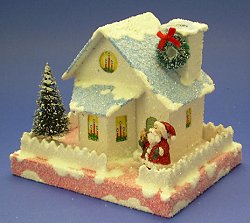 Building a Bay Window House Building a Bay Window House
This project is based on our earlier Picture Window House project. It represents a small subset of "putz" (Christmas cardboard village) houses that included more complex architectural designs. This structure includes a "bay" window that projects from the front of the house. We have included graphics for the candles in the windows.
What You Will Need
Clean cardboard. You can use cardboard from cereal boxes, the backs of writing tablets, anything flat, firm and clean. You'll also probably want to use corrugated cardboard for the base. In addition, for this project you'll need:
- A sharp mat knife or Xacto knife (or both)
- A stiff metal ruler
- Elmer's white Glue-All. A glue stick would also come in handy.
- Clear glitter. I use the “Sulyn” brand.
- Several sheets of acid-free, non-yellowing, white bond paper
- Flat white paint (flat latex interior wall paint is good) to prime the building (and give it the chalky feel of the original)
- Acrylic paint in the colors you plan to use for the house
- A hole punch for making the pattern in the fence (optional)
- Clear packing tape (optional, depending on the approach you use)
- Vellum or other printable translucent medium you can use for the windows. You CAN use a sheet of the non-yellowing white bond paper in a pinch, but the candles won't "glow" as brightly. If you use paper, consider using clear celophane or packing tape over the candle printouts you put into the windows.
- The paper door I used is available from www.papatedsplace.com.
Ted Althoff has a full line of reproduction doors plus red “cellophane type” and paper windows.
- Access to the Internet and a color printer
- Sand to add texture to the paint (optional - in this case, we simply used glitter to finish the house. If you want to use a sand finish instead, refer to the Picture Window House project for details on that).
- Other accessories, such as bottle brush trees, that you plan to use to finish the house.
Note: Our article on What You Need to Build Glitterhouses lists many other materials and tools that will help you work more quickly and effectively.
Printing the Plans
Because this house is based on the Picture Window House project, we have included those plans for your reference, as well as a new "front of house" plan that includes the parts for the bay window.
If you want to see the plans before you print them, you can see a bigger version by clicking on the graphics above. But the best way to print them is to click the following links to download the PDF versions:
Select the print option, tell it to "auto rotate and center" or whatever else you need to make it go to Landscape mode. Don't select the "scale to page" or "shrink to fit" option. Print.
Note: On most printers, a small portion of the first image will disappear at the outside edge of the page. But you can easily "fill in the details" by looking at the jpg version - if you allow your printer to reduce the size of the drawing to fit the "printable" page, your plans will be about 5% too small.
If you don't have Adobe Acrobat Reader on your computer or for some reason that doesn't work, you can open the big JPG versions by clicking on the reduced plans above. Choose the "file, page setup" from your browser. When the page setup menu comes up, select "landscape mode." Choose the "scale to fit" option (sometimes "print as large as possible" or something like that. You may have to tweak the sizes a little to get them just right, though - that's why the PDF versions are more likely to work for you.
If neither of those work, contact
Paul and ask him for help - that's his department. :-)
Building the Base
The base is a rectangular "box" that is decorated before the house and trees are installed. For this project, it should be about 4" x 5" and about 1/2" high.
Cut the Base Pieces - The base is made from heavy corrugated cardbard, the kind they use in big boxes. The fence pieces are made from fine corrugated stock, like that from the small express mail boxes you get at the post office. The same kind of fence can also be cut from heavy card stock such as back of a writing tablet. If you wish, you may use different materials for the fence, such as a miniature wooden snow fence from the craft store or a rustic rail fence you make from twigs.
Glue The Base - Build the base up from layers of corrugated cardboard glued together in a sandwich. You then wrap and glue a strip of thin poster-board or cereal-box cardboard all around it to smooth over the rough edges of the corrugated cardboard.
Wrap the Base - When the base is built and the glue is dry, you cover it with white bond paper just like you would wrap a gift, except that all surfaces of the paper cover must be completely glued down to the box. A glue stick works great for this.
Note: More details about building bases are provided in our article: Building Glitterhouse Bases
Cut the Fence Pieces - Note: The fence in the photo is not the same fence shown on the plan. For this project, I chose to cut a "picket-fence" pattern, but you may make any sort of fence you want, of course. The fence pieces are made from fine corrugated stock, like that from the small express mail boxes you get at the post office. The same kind of fence can also be cut from heavy card stock such as back of a writing tablet. If you wish, you may use different materials for the fence, such as a miniature wooden snow fence from the craft store or a rustic rail fence you make from twigs.
Attach the Fence - When the glue on the base has dried, glue the fence pieces to the base.
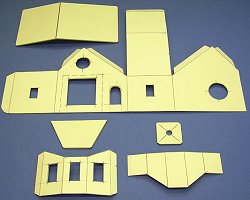 Cutting Out the Structure Pieces Cutting Out the Structure Pieces
- Carefully transfer the patterns of all pieces to the cardboard building stock. A .05 mm lead mechanical pencil and a “C-Through” brand ruler make this accurate and easy. Note: When you are transferring the pattern for the front of the house, transfer the pattern from the "PDF File for Bay Window modification" instead of the pattern from the Picture Window House.
- Put new blades in the mat knife or X-acto knife (or both) that you will be using.
- Score the fold lines before you begin cutting out the parts (although you may score the roof pieces later, if you wish, after you've checked the overhang). Use the metal ruler or other steel edge as a guide.
- Still using a steel-edged ruler as a guide, cut out the shapes. Watch your fingers.
Assembling and Painting the House
Note: You'll notice that there is some "hurry up and wait" involved with this portion of the project. That's one reason I often work on more than one building at a time. - Using Elmer's white Glue-All or a similar product, assemble the house pieces.
White glue works best if you apply a thin coat to each mating surface and wait a few moments for the glue to become tacky. Do not glue the house to the base yet.
- Glue the chimney and chimney cap together.
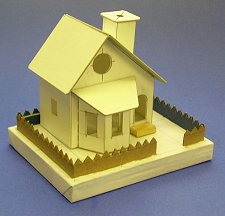 When the glue is dry and you feel that the structure is "sound," double-check the roof size. The most important thing is that it has an overhang on all sides just like a real house. After you determine where the peak of the roof should be, score the crease. Make any adjustments to the outside shape of the roof as necessary, and glue on the roof. When the glue is dry and you feel that the structure is "sound," double-check the roof size. The most important thing is that it has an overhang on all sides just like a real house. After you determine where the peak of the roof should be, score the crease. Make any adjustments to the outside shape of the roof as necessary, and glue on the roof.
- When the glue for the roof is dry, glue on the chimney.
- Prime the base, fence, and house, including trim, with flat white wall paint. Don’t skip this step; it gives you a uniform surface for painting.
- Once the base coat is dry, paint the house in your choice of colors. I use acrylics from the Wal-Mart craft department. For anything that is painted gold, silver or bronze, I use “Testors” brand model paint.
- Paint the base and fence. A white base with random swirls and dabs of very light pastel blue and pink are a good choice. Paint the fence a color that ties in with the rest of the house but is dark enough to contrast with the base. I suggest you not use yellows, beiges or greens in the snow.
 Picture Window HousePaint white patches for "snow" on the roofs and chimney. In addition to the photos for this article, these photos from the Picture Window House project will give you some ideas. Picture Window HousePaint white patches for "snow" on the roofs and chimney. In addition to the photos for this article, these photos from the Picture Window House project will give you some ideas.
- Add clear glitter to the house and the base. Brush on a thin, but even coat of undiluted white glue and sprinkle on the glitter. Don’t try to do the entire house or base at once. White glue starts to film-over and dry quickly so just do a wall or a section at a time. The glue dries clear so don’t judge the final look until the glue is dry.
- When you're satisfied with the overall look of the house, glue your windows in place inside the structure.
- Glue the finished house to the finished base. Fill in any gaps between the house and the base with white glue and sprinkle on more glitter.
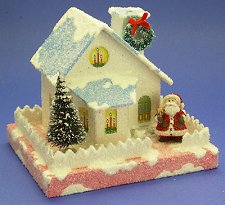 Adding Additional Scenery Adding Additional Scenery
Add yard accessories such as bottle-brush trees, as desired.
[Editor's note: For trees, some folks cut apart a loofah sponge and dip it into deep blue-green paint, wring it out, and let it dry to simulate the lichen-like organic material used on some of the original houses. - Paul]
When everything is glued together and the glue has dried, touch up any place that the glitter hasn't covered evenly.
If you wish, you can use several light coats of clear satin acrylic spray to protect the paint, glitter, sand, and graphic from handling and light.
Conclusion
You can see that, when you get to the gluing, painting, and glittering stages, there's a lot of "hurry up and wait." That's one reason many people who build modern putz house recreations work on two or three houses at the same time - you can work on the second house while the glue is setting on the first one, and so on.
[Editor's note: Howard has three grown children with families and Christmas villages of their own, which is why he often makes four buildings at the same time, so he gets to keep one. - Paul]
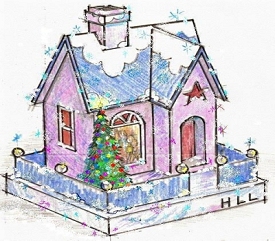 Commercial "Plug" - Now that I'm in "retirement," this hobby has become a sort of avocation for me. Several folks have commissioned me to build specific houses for them. I often provide an "artist's conception" such as the one at the right to make certain I understand what they want. Sometimes the "artist's conception" needs to be tempered by adjustments to make the house fit in better with the other houses it will be joining, as well as color and accessory changes. But it all starts, quite literally, at the drawing board. Commercial "Plug" - Now that I'm in "retirement," this hobby has become a sort of avocation for me. Several folks have commissioned me to build specific houses for them. I often provide an "artist's conception" such as the one at the right to make certain I understand what they want. Sometimes the "artist's conception" needs to be tempered by adjustments to make the house fit in better with the other houses it will be joining, as well as color and accessory changes. But it all starts, quite literally, at the drawing board.
Perhaps you had a pasteboard house collection when you were young and would like to have a replica made. Or you have an idea for somthing that's never been done. If you can find a photo or hash out a drawing or anything else to give me some idea of what you're looking for, that can be enough to get started.
If you'd like me to help you design and/or build a special vintage pasteboard house for you, or if you have any questions at all, please see my site, LittleGlitterHouses.com for more information.
Looking for Your Ideas, Projects, or Photos - Also, if you have similar project, ideas, or photos that you'd like to share with your fellow readers and hobbyists, we'd love to add them to our sites, and we'll be sure to give you full credit for your contribution.
Other Resources for Putz Houses and Related Information
Other Putz House Articles:
- What is a Glitterhouse? - Our introduction to the hobbies of collecting and building glitterhouses.
- Building Glitterhouse Bases
 What You Need to Build Glitterhouses What You Need to Build Glitterhouses
- Building a Glitterhouse - A detailed primer on starting your own glitterhouse hobby, including free downloadable plans and detailed instructions for making simple houses and churches.
  Building the Little Charmer - A new glitterhouse project that is a step up from our beginning glitterhouse. Includes free downloadable plans. Building the Little Charmer - A new glitterhouse project that is a step up from our beginning glitterhouse. Includes free downloadable plans.
- Building a Picture Window House - Another new glitterhouse project. This one includes unique features such as a sand finish and picture window that reveals a "Christmas scene" Includes free downloadable plans and directions.
- Building the Union Station - This original project by designer Howard
 Lamey is inspired by two traditions - the cardboard Christmas houses that were popular in US homes between 1928 and 1965 and the Lionel station that was popular for most of the 20th century. Lamey is inspired by two traditions - the cardboard Christmas houses that were popular in US homes between 1928 and 1965 and the Lionel station that was popular for most of the 20th century.
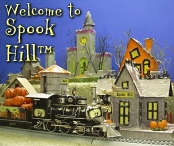 Welcome to Spook Hill™ - Howard has designed a whole, family-friendly, Halloween community built in the vintage "putz-house" style. Includes many free downloadable plans, photos, and detailed instructions. Welcome to Spook Hill™ - Howard has designed a whole, family-friendly, Halloween community built in the vintage "putz-house" style. Includes many free downloadable plans, photos, and detailed instructions.
Other Putz House Resources:
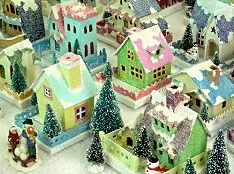
- LittleGlitterHouses.com - Putz house builder Howard Lamey now has his own site, begun in December, 2007. You can get ideas for your own project, commission your own custom-built glitterhouse, or buy a precut kit and finish it yourself.
- "Papa Ted's Place" Ted Althof's extensive resource about vintage pasteboard houses. Includes some history, many photos from other people's collections, and resources to help you build your own. The links below will take you right to the approprate page on "Papa" Ted's site. You'll find lots of other pages to look at while you're there, though.
- Author Antoinette Stockenberg's home page - includes photographs and comments on putz houses and life in general.
Other Articles that Discuss Putzes and Christmas Villages of the mid-20th Century:
- About Nativities - Describes how German-American Nativity displays (the original "putzes") grew into communities and landscapes that included pastboard, glittered houses and even electric trains.
- What Do Trains Have to Do With Christmas - Describes how electric trains contributed to the communities many families set up at Christmas, with some details about the elaborate "Christmas Gardens" of the Baltimore/DC area.
|

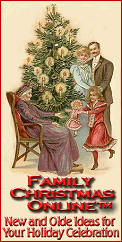
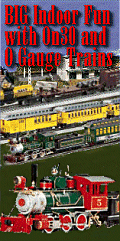

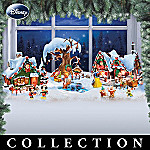





|





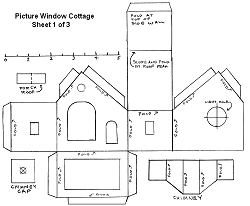
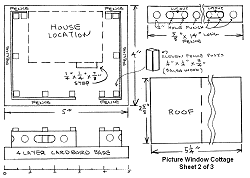
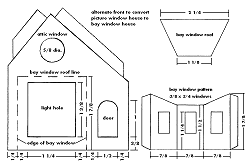
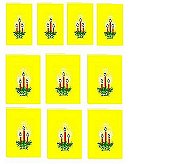
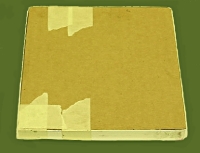
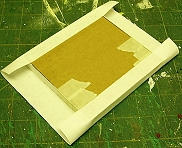
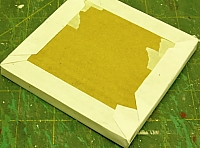


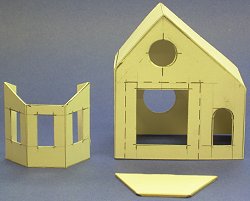
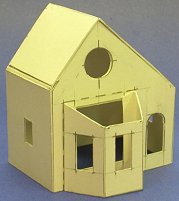






 Building the Little Charmer
Building the Little Charmer
 Welcome to Spook Hill™
Welcome to Spook Hill™
 Reproduction Parts
Reproduction Parts














